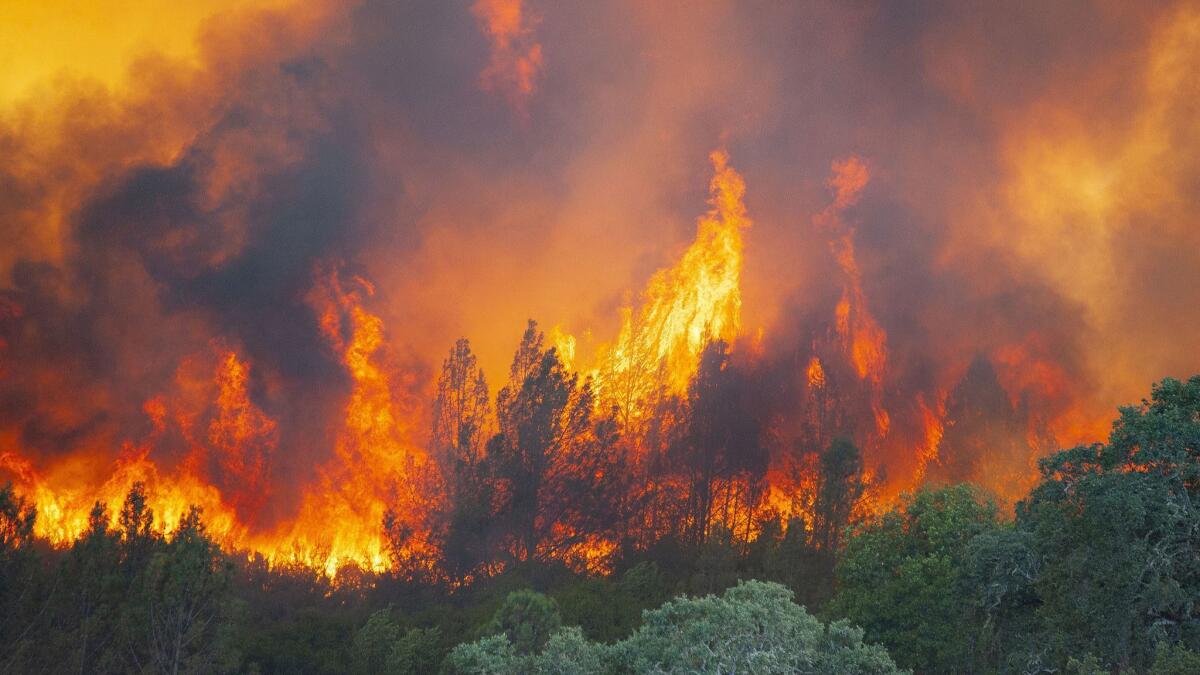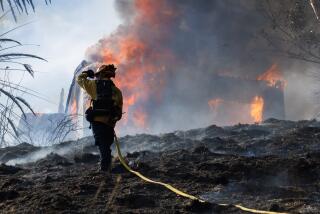A bipartisan duo of California lawmakers wants to spend climate-change cash on thinning out fire-prone trees and brush

Reporting from Sacramento — Two members of the California Legislature who represent fire-ravaged regions, one a Democrat and the other a Republican, have crafted a wide-ranging plan to spend as much as $300 million a year in climate-change cash on ways to speed up the removal of trees and brush that fuel the state’s blazes.
The proposal may be the most detailed produced so far by wide-ranging discussions in Sacramento on a statewide wildfire prevention strategy. The lawmakers, whose work has been overshadowed by high-profile efforts to lessen fire liabilities for electric utility companies, hope to refocus the conversation on local prevention efforts.
“It’s about prudent vegetation management to get in and remove the fuel load that’s there,” said Assemblyman Jim Wood (D-Healdsburg), one of the plan’s authors. “There’s a concern that we’re going to advocate for huge logging out there. That’s not who I am.”
The plan by Wood and Assembly Republican Leader Brian Dahle (R-Bieber), which has not been formally unveiled this week, aims to expedite removing fire-threatened trees from mountain and foothill regions, as well as shrubby chaparral in coastal communities. In some cases, private landowners would be given new freedom to sell the lumber from smaller trees that otherwise would fuel bigger fires. The proposal would also expand state firefighter tree and vegetation management efforts to at least a half-million acres a year.
“We have no time for partisan politics right now,” Dahle said. “We’re losing property and lives.”
Some of the efforts would be paid for with revenues collected from the sale of carbon emissions credits bought by companies as part of California’s cap-and-trade program. Initial cost estimates for Wood and Dahle’s plan are as much as $300 million a year, potentially a tough sell for some environmentalists who believe climate change dollars should subsidize a number of other projects.
Wood, a Democrat who has earned high marks from environmental groups in the past, said the emissions from weeks and weeks of smoke show the proposal has a clear connection to climate change mitigation efforts.
“We don’t react to changing times quickly enough,” Wood said. “These fires are massive and we need to take a massive step to react to that — and to do something to help combat that.”
The two men, whose Assembly districts are adjacent to each other in covering the entire northern part of the state, are part of what has been informally called a “fire caucus” of legislators whose communities have been hard hit over the past year. While they don’t always speak with one voice, those lawmakers have led many of the discussions over new fire prevention efforts.
In separate interviews, Dahle and Wood praised each other for seeking common ground.
Dahle, who represents Redding, where six people were killed during the Carr fire, said one of the first people who called him last month to offer advice was Wood, who saw some of his Sonoma County communities flattened by fire last fall. It was the beginning of conversations that led to the policy proposal now being pitched in statehouse negotiations.
“Both of our districts have suffered huge blows,” Dahle said. “Fire knows no boundaries.”
But the proposal by the two lawmakers will still face concerns. Key among those is the inclusion of new help for biomass energy plants, which burn wood and waste to produce electricity. Their proposal would help many of those plants, which have struggled in recent years, to stay open and process significant amounts of the wood removed from overgrown areas. It would extend by several years existing contracts those facilities, many privately owned, have with electric utility companies. And efforts would be made to expand the market for products made from woody biomass leftovers.
But environmental groups contend biomass plants produce too much pollution, and might balk at the lawmakers’ plan to retrofit the facilities for cleaner burning of wood and waste projects.
“California should not use hazardous trees to prop a polluting and non-economic biomass incineration industry,” Daniel Barad of the Sierra Club said at a Capitol hearing last month.
The lawmakers who crafted the proposal are likely to argue the pollution from the plants pales in comparison to that generated by the fires.
“If we are truly looking at reducing greenhouse gases, we need to focus on the biggest emitter of greenhouse gases, and right now that’s forest fires,” Wood said.
Even so, the issue could be one of several sticking points. Difficult, too, will be convincing residents in some rural communities that they should provide more access to their property for tree and vegetation removal.
“There are certainly parts of my district where people say, ‘It’s my land, stay off my land, I don’t want to do anything to my land,’ ” Wood said. “And they’re Democrats.”
What may be easier to sell in the Capitol is the proposal’s push for streamlining tree and brush removal efforts that frequently trigger the need for multiple, sometimes overlapping authorizations from all levels of government. The two lawmakers are proposing the creation of a state Office of Wildland Resiliency to expedite such projects, and to oversee funds to be spent on the efforts.
In all, there are as many as a half-dozen potential pieces of legislation being considered to create a reliable statewide fire prevention effort. It remains unclear how many of those will become bills taken up by the Legislature, and how many might be rolled into an omnibus plan crafted by the special conference committee convened last month. If that happens, there is a risk — one that has appeared in big political battles of the past — that warring interest groups could pick apart the provisions they oppose and the effort topples under its own weight.
“There can be pushback on everything,” Dahle said. “But they don’t have any other solutions.”
Follow @johnmyers on Twitter, sign up for our daily Essential Politics newsletter and listen to the weekly California Politics Podcast
More to Read
Get the L.A. Times Politics newsletter
Deeply reported insights into legislation, politics and policy from Sacramento, Washington and beyond. In your inbox three times per week.
You may occasionally receive promotional content from the Los Angeles Times.











